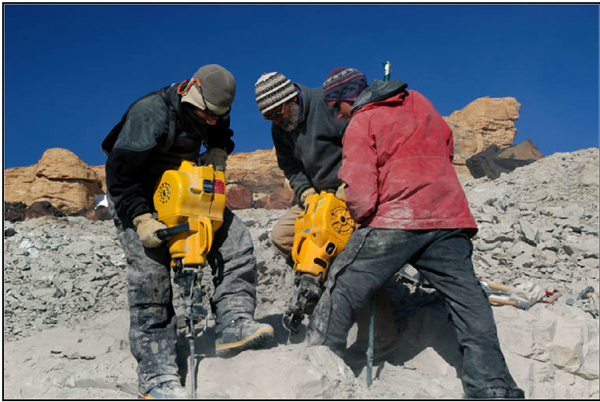
Painting by William Stout; copyright William Hammer |
Artist’s reconstruction of Glacialisaurus hammeri and Antarctica during the Early Jurassic 190 millions years ago, with several pterosaurs in the background, and a small mammal-like reptile in the foreground. Scientists recently confirmed that remains found 15 years ago in Antarctica belong to the previously undiscovered G. hammeri. |
A big find
Scientists describe previously undiscovered dinosaur that lived 190 million years ago
From Staff Reports
Posted December 20, 2007
Previous Dinosaur Coverage
More than 15 years since first discovering dinosaur bones on Antarctica’s Mount Kirkpatrick, scientists confirmed this month that the remains belonged to a previously undiscovered genus and species from the Early Jurassic.
The massive plant-eating primitive sauropodomorph is called Glacialisaurus hammeri and lived about 190 million years ago. A description of the dinosaur was published Dec. 5 in the online journal Acta Palaeontologica Poloncica.
The recently published description of the dinosaur is based on partial foot, leg and anklebones found on Mount Kirkpatrick near the Beardmore Glacier in Antarctica at an elevation of about 4,000 meters.
Nathan Smith, a graduate student at The Field Museum in Chicago, and Diego Pol, a paleontologist at the Museo Paleontológico Egidio Feruglio in Chubut, Argentina, co-authored the paper.
“The fossils were painstakingly removed from the ice and rock using jackhammers, rock saws and chisels under extremely difficult conditions over the course of two field seasons,” Smith said in a news release from The Field Museum. “They are important because they help to establish that primitive sauropodomorph dinosaurs were more broadly distributed than previously thought, and that they coexisted with their cousins, the true sauropods.”
Bill Hammer, a paleontologist with Augustana College, had led the expedition that discovered the dinosaur bones during the 1990-91 summer season. During the same field season, Hammer had dug up the remains of the first, and only, carnivorous dinosaur found in Antarctica. The 22-foot cryolophosaurus turned out to be the oldest of its kind from anywhere in the world.
“Anything we find down here is very different from other parts of the world,” Hammer told the Sun during the 2003-04 field season when he and a team returned to Mount Kirkpatrick to collect more cryolophosaurus bones.
The science team that year found the bones of a possible sauropod about 100 meters from the original dig. But they are unrelated to G. hammeri, Smith said via e-mail. Those remains are still being prepared at Augustana College, he added.
G. hammeri, named in honor of Hammer, was no pipsqueak. It tipped the scale somewhere between 4 and 6 tons, and was probably about 20 to 25 feet long.
In fact, sauropodomorph dinosaurs were the largest animals to walk the earth. They were long-necked herbivores and included Diplodocus and Apatosaurus. Their sister group is the theropods, which include Tyrannosaurus, Velociraptor (the starring beastie of the Jurassic Park movie) and modern birds.

Photo Courtesy: Nathan Smith
Kevin Kruger, Peter Barrett and Nathan Smith (from left) excavate dinosaur bones in 2003-04 on Mount Kirkpatrick.
Currently, paleontologists hotly debate the development and evolutionary relationships of the sauropodomorph dinosaurs. This discovery, however, helps to resolve some of this debate by establishing two things, according to Smith.
First, it shows that sauropodomorphs were widely distributed in the Early Jurassic. “This was probably due to the fact that major connections between the continents still existed at that time, and because climates were more equitable across latitudes than they are today,” Smith said.
That was the time just before the super continent known as Gondwana began to break up. The separation began around the Middle Jurassic, about 167 millions years ago, when East Gondwana — comprising Antarctica, Madagascar, India and Australia — began to separate from Africa.
Second, the discovery of G. hammeri shows that primitive sauropodomorphs probably coexisted with true sauropods for an extended period of time. The more recent discovery of the possible sauropod at roughly the same location in Antarctica lends additional evidence to the theory that the earliest sauropods coexisted with their simpler sauropodomorph cousins, including G. hammeri, during the Late Triassic and Early Jurassic, Smith and Pol conclude in their research findings.






